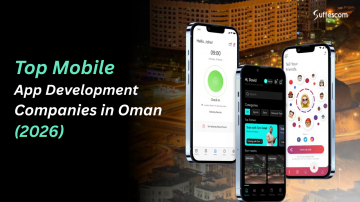eCommerce App Development in 2026: Cost, Steps & Essential Features

In this new, rapidly emerging digital environment, eCommerce apps have shown to be a vital component of how businesses operate and customers shop. Presently, these applications not only increase comfort and accessibility but perform the key function of providing a company with access to a global audience. When approaching the year 2026, the eCommerce segment remains an area demonstrating tremendous change. Novel trends such as AI, augmented reality, and blockchain is redesigning user experience with the help of online marketplaces.
As a result, the following guide offers a blueprint for eCommerce app development in 2026. This within app guide will lead you from concept and design to build and support as it provides an overview of best practices for creating an app that helps grow your business.

Understanding the eCommerce Landscape in 2026
Market Trending Technologies in eCommerce:
Ecommerce is expected to do well in 2026, with great potential in many sectors. Marketers predict the global eCommerce market will provide higher returns than in previous closing years. Since there have been increased total sales and the number of eCommerce users. Here are the key tendencies shaping the industry verticals:
Mobile-First Approach: Given that most Internet site visitors today access websites from their mobile devices, any business endeavors to optimize its structures to improve consumer satisfaction with the product and increase sales.
Personalization: Using record analytics, the acquiring experiences are very distinct within eCommerce systems, offering product recommendations and advertising messages corresponding to character attributes.
AR/VR Integration: AR/VR redefines the buying experience by virtually placing it in the hands of clients to show them products with the view of offering them a real-time in-shop experience from the comfort of their homes.
AI and Machine Learning: These technologies enrich the various aspects of eCommerce, from having 24/7 chatbot support to AI suggestions that improve customer satisfaction and sales.
Blockchain for Secure Transactions: Through blockchain technology, e-commerce is becoming stable, transparent, safer and dependable transaction methods, reducing emanates and agreeing with virtual transactions.
Impact of 5G on Mobile eCommerce: The deployment of 5G networks is set to enhance mobile eCommerce, offering faster, more dependable internet connections that facilitate the seamless integration of advanced technology like AR and VR.
Upfront Planning of eCommerce App Development
Defining Your Target Audience: Understanding your target market is essential for growing an eCommerce app that resonates with customers and meets their needs.
Setting Clear Objectives: Determining clear objectives and goals is crucial for your eCommerce or Shopping App Development. Identify your Unique Selling Points (USPs) that align with your business desires, budget, average order cost and custom satisfaction. These parameters will assist you in measuring the app’s overall success and making business-driven development decisions.
Competitive Analysis: Understanding your opposition is prime for differentiating your app in a crowded marketplace. Assess the strengths and weaknesses of your competition's apps to discover gaps and opportunities. Look at user interface, functions, pricing strategies, consumer reviews, and advertising approaches. Use this evaluation to differentiate your app and offer a superior cost to your target audience.

Crucial Features for an eCommerce Mobile App Development
User-Friendly Interface
An eCommerce app's UI/UX layout considerably impacts consumer engagement and satisfaction. A user-friendly interface guarantees that customers can navigate the app results easily, discover products quickly, and complete their purchases with zero hassle.
Personalized Shopping Experience
Personalization is primary to modern eCommerce apps, with AI-driven recommendations tailoring the shopping experience into personal possibilities and behaviours. The app can suggest relevant merchandise by reviewing past purchases, browsing history, and individual demographics, increasing the conversion probability.
Seamless Payment Options
A seamless payment technique reduces cart abandonment and complements the checkout experience. Integrating multiple payment gateways, including PayPal, Stripe, and conventional credit/debit card options, allows users to select their favoured payment method.
Advanced Search and Navigation
Effective search and navigation functions are essential to improving the personal experience in eCommerce apps. Advanced search capabilities, including voice search, allow customers to locate merchandise fast using spoken commands, specifically for cell customers and people who prefer hands-free interactions.
AR/VR Integration
Augmented reality (AR) and virtual reality (VR) take the eCommerce shopping experience to a new level by merging online and offline shopping experiences. Interactive tools help clients see how they would look wearing specific garments, accessories, and makeup, making buying a more convincing experience.

Time-savvy eCommerce App Development Process
Conduct Market Research
Remember, there is no point in working on your eCommerce app without first conducting a market analysis to validate your idea. A few things should be investigated by any eCommerce app research, including competitor research and surveys of the kinds of things potential users want from an eCommerce app.
It will also inform you what features and functions your app should possess and how it should align with the existing eCommerce systems. You can create your eCommerce mobile application after analyzing the market and customer requirements.
Select the Correct Web Store.
Due to this, the platform you will employ for your eCommerce app development project defines the project's success. It has to support the number and richness of interactions that an eCommerce app requires to support.
Set Your eCommerce Goals
It is essential to determine your objectives for eCommerce to prepare your app layout for development. Marketing objectives range from simply reaching more people within the customer base to engaging this customer more frequently. Determining goals at the beginning of the eCommerce app development is essential. They will dictate how your eCommerce application will look and function.
Create the eCommerce User Interface (UI)
That means the UI design is one of the key aspects of your app development. It enhances the user interface and the overall outlook of the eCommerce store for the customers. It would also be beneficial if the eCommerce UI were tailored to the customer's needs.
- Shopping Cart / Checkout: The functionalities like shopping cart and checkout commonly form part of any eCommerce application. Those include enabling the customer to input the product they wish to purchase, check the order's cumulative price, input their shipping information, and complete the payment process.
- Payment Gateways: Other related benefits taken under payment gateways include enabling customers to accept various payments. Stripe, PayPal, Apple Pay, and other service providers are well-known global payment gateways.
- Order Management System: An OMS helps you track customer orders through the supply chain from when they place the order to when they receive it. These include controlling the stock status for items, storing and/or updating customer information, handling product inventory counts, flexibilities for pricing, and so forth.
When eCommerce features are complete, you'll need to test them thoroughly with the help of a custom eCommerce app development company. This involves ensuring that they work in all browsers and mobile devices and checking for security vulnerabilities, which is the following item to consider when developing an eCommerce app.
Test eCommerce App
Once the eCommerce app is fully developed, testing them thoroughly before launching them is essential. This is where Suffescom App Testing Services can come in. They provide comprehensive testing services for eCommerce apps, from functional and performance tests to usability and compatibility tests.
This way, eCommerce vendors can rest assured that their apps are up to the mark before launching them on the marketplaces. Once the app has been tested and verified by QA/testers, we are ready to launch it on the app marketplaces.
Launch eCommerce App
After thorough testing, you can launch your eCommerce app and drive sales. However, plan to continue app development and maintenance as customers' expectations change. This will help ensure your eCommerce mobile app stays up-to-date and relevant to the market.
As you develop your apps, you must monitor competitors in the eCommerce space. Analyze what they're doing right and wrong and adjust your strategy accordingly. That way, you can stay ahead of the competition and ensure your app stands out!
Transform Your Business with eCommerce Mobile App Development
Enhance customer engagement and boost sales with a sleek, intuitive eCommerce mobile app. Let us develop a seamless shopping experience that keeps your customers returning for more. Kickstart your eCommerce app development journey today!
Cost Affecting Factors of eCommerce App Development
App Complexity and Features
One of the cost conflicts related to an eCommerce app arises from the app’s design. Applications with fewer features, including product lists, search capability, ‘shopping carts’ and secure payment methods, can be created quickly and at a lower cost, as these feature sets require minimum resources and time to set up. However, you should endeavour to add features like the AI Recommendation system, AR for Try-ons, or Unique User Experiences. In that case, the work gets complex and requires experts and a longer development duration, automatically raising the price.
Platform Resolution (iOs, Android or Both)
Another significant cost factor is the platform selection for your eCommerce app. Building a native app for a standalone platform means either IOS or Android tends to be cheaper than building native apps for both. But, if it is necessary to attract more users, it is essential to create applications for both operating systems. Another way of cutting costs is to use cross-platform development by employing frameworks such as React Native or Flutter to build a usable application on various platforms. However, this may not render the application as efficient as the one developed for a specific platform or provide full access to all respective platforms’ unique features.
UI/UX Design
Hiring professional UI/UX designers means that a user will find it easy and be able to interact with your app. High-quality interface design can increase perceived value but hurt the cost of development. The widespread non-unique solutions, such as templates, are less expensive than personal, unique designs that may include graphics, animations, and adaptive grids and columns.
Backend Development
Backend development of an eCommerce app involves configuring servers, databases, and APIs that support the app and consolidations that make the application run seamlessly. The backend systems are complex depending on the application and its functional qualities. For example, those dealing with extensive stock, involving various payments, or having heavy security needs need more sophisticated backends.
Partner with a Leading Custom eCommerce App Development Company
Collaborate with industry leaders in custom eCommerce app development. We specialize in creating powerful, scalable apps that drive growth and maximize your online potential. Contact our expert team of eCommerce app developers today to start your project.
Conclusion
Nowadays, designing and launching a strong eCommerce application is not a sign of being fashionable; it is a necessity. For a start-up firm seeking to create an impact or an experienced business desiring to increase its customers’ satisfaction, eCommerce app development can contribute immensely to the improvement of the business. If you choose a custom eCommerce app development company, you can be sure your app will meet the competition and provide a unique shopping experience to your customers. Take your first step toward digital transformation now and be ready to play the eCommerce game on the right side.








